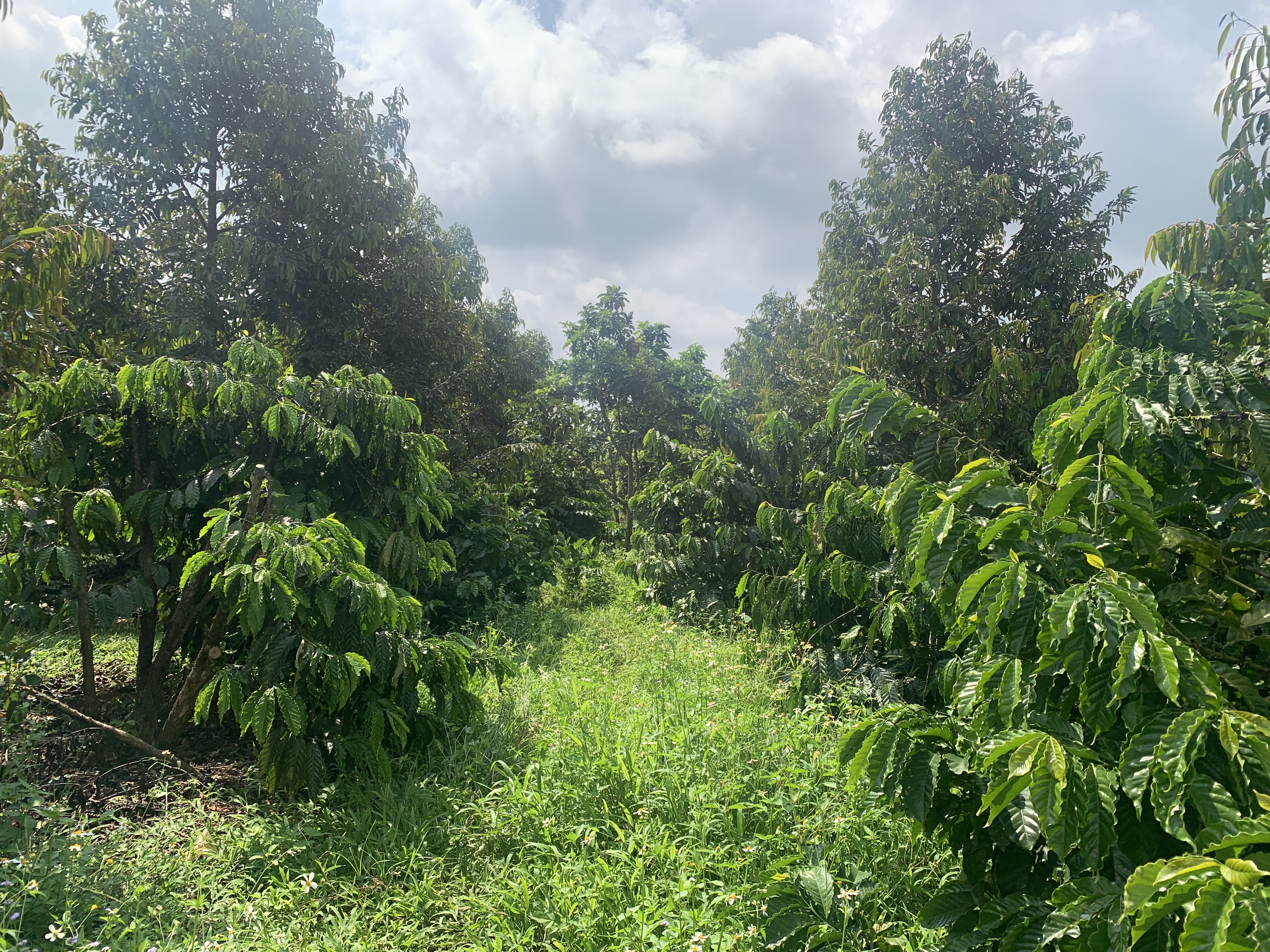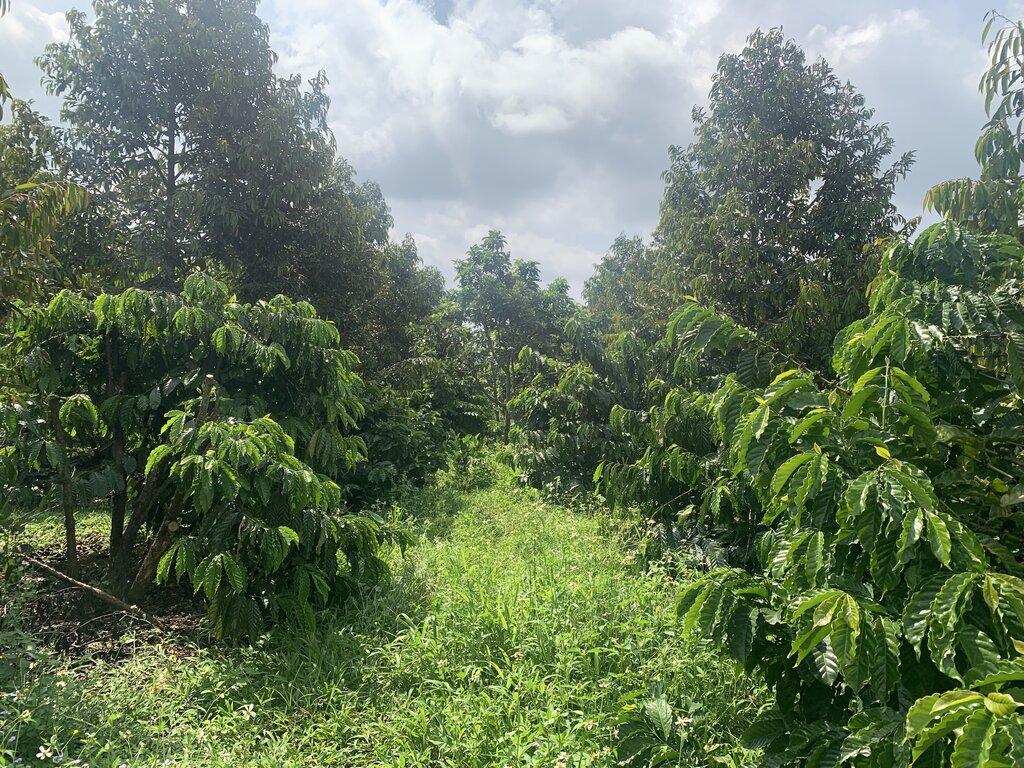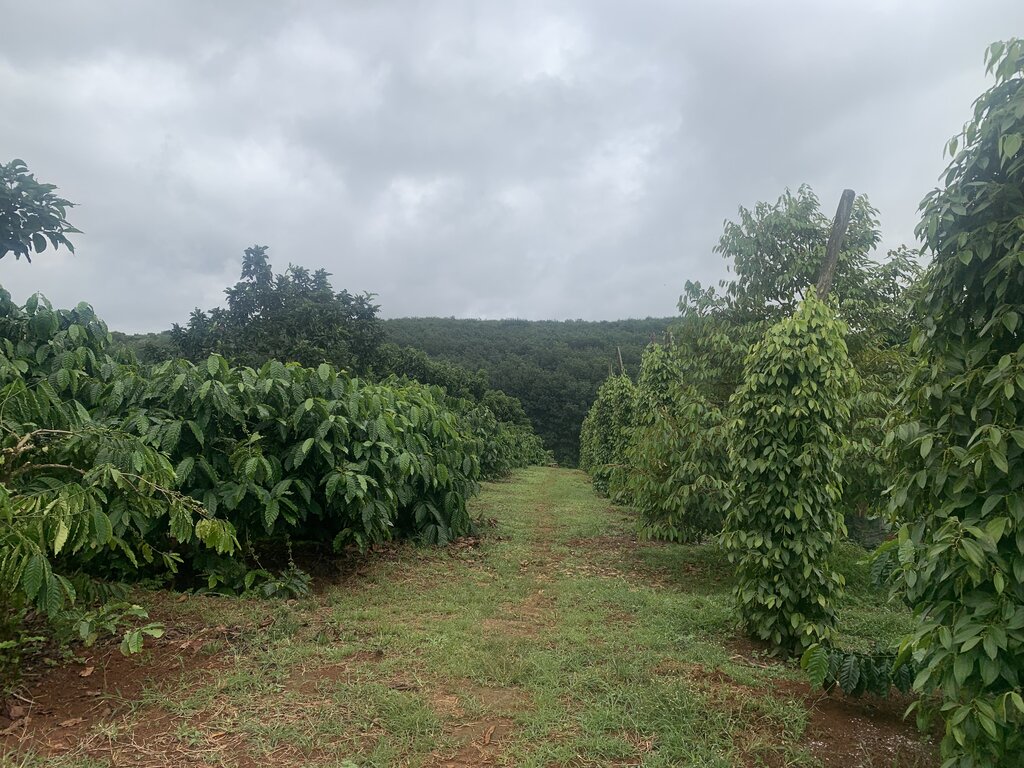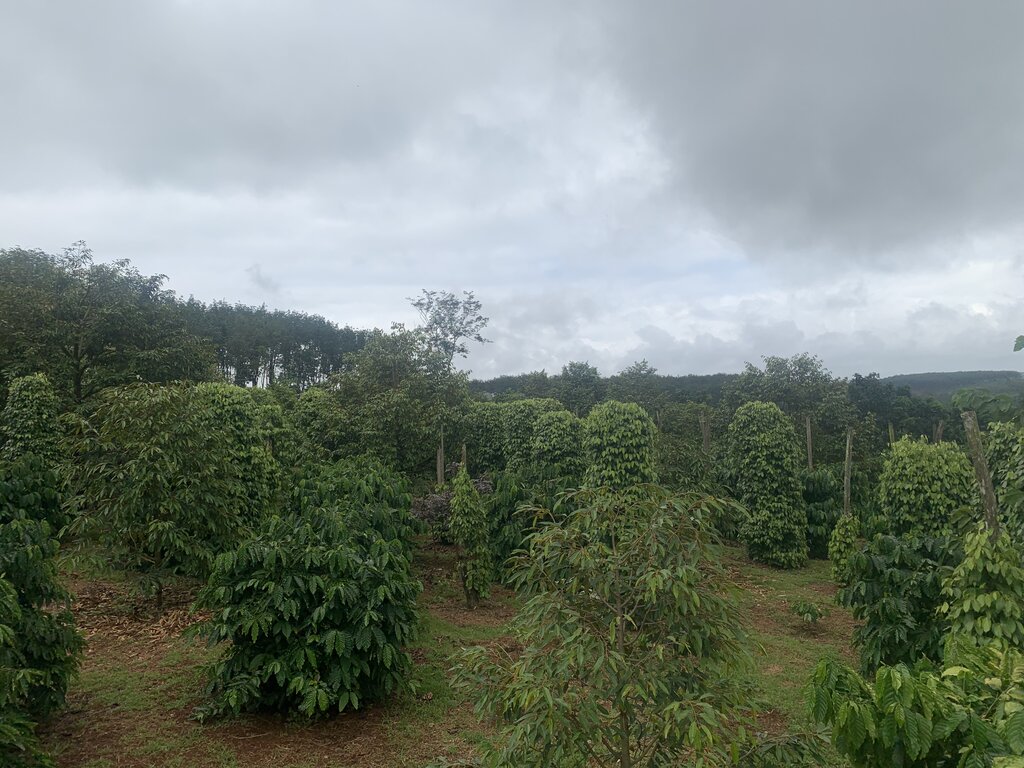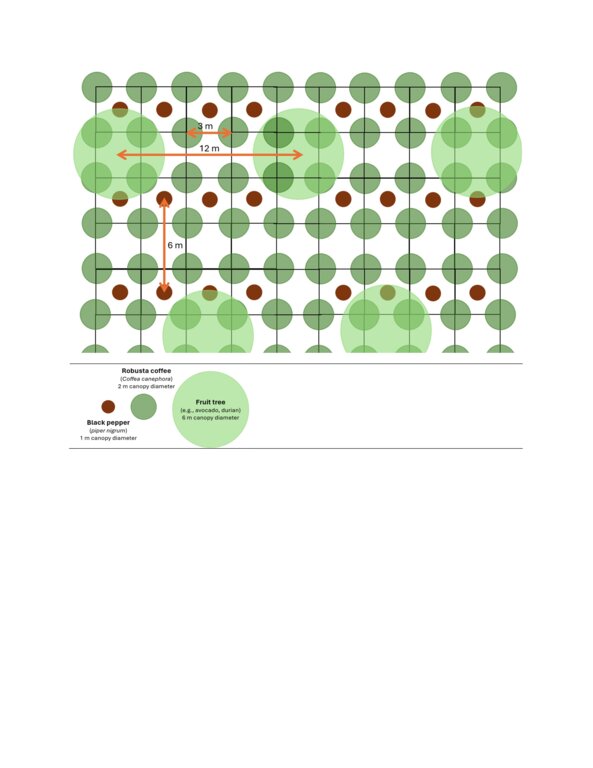Multi-storey intercropping with coffee and fruit trees [越南]
- 创建:
- 更新:
- 编制者: Carlos Gil Picon
- 编辑者: Eric Rahn
- 审查者: William Critchley, Rima Mekdaschi Studer
Mô hình trồng xen cây ăn quả trong vườn cà phê
technologies_7387 - 越南
查看章节
全部展开 全部收起1. 一般信息
1.2 参与该技术评估和文件编制的资源人员和机构的联系方式
关键资源人
co-compiler:
Ha Tuan
Nguyen University and CIAT
越南
有助于对技术进行记录/评估的项目名称(如相关)
Land Use Based Mitigation for Resilient Climate Pathways (LANDMARC)有助于对技术进行记录/评估的机构名称(如相关)
Alliance Bioversity and International Center for Tropical Agriculture -Vietnam (Alliance Bioversity-CIAT)1.3 关于使用通过WOCAT记录的数据的条件
编制者和关键资源人员接受有关使用通过WOCAT记录数据的条件。:
是
1.4 所述技术的可持续性声明
这里所描述的技术在土地退化方面是否存在问题,导致无法被认为是一种可持续的土地管理技术?:
否
2. SLM技术的说明
2.1 技术简介
技术定义:
Robusta coffee in the Central Highlands of Vietnam is intercropped with pepper vines and fruit trees thus increasing the total planting density. This leads to higher land equivalent ratios compared to monocropping, thereby increasing land use efficiency, profitability, soil protection and resilience.
2.2 技术的详细说明
说明:
Robusta coffee in the Central Highlands of Vietnam is intercropped with pepper vines and fruit trees, increasing the total planting density. This leads to higher land equivalent ratios (LER) compared to monocropping, thereby increasing land use efficiency, profitability and resilience. The increased plot-level biomass stock also confers better soil protection, and more biomass is returned to the soil through prunings and natural litter formation.
There are a variety of multi-storey intercropping designs based on coffee (Coffea canephora), black pepper (Piper nigrum), avocado (Persea americana), durian (Durio zibethinus) and macadamia (Macadamia integrifolia). An example of a recommended intercropping design is coffee with pepper vines (supported by living poles of Ceiba pentandra, Cassia siamea, Paulownia spp. etc) and fruit trees at densities of 887 coffee bushes, 336 pepper vines, 28 avocado trees and 28 durian trees per hectare (D’Haeze 2022; Rigal et al. 2023). Agronomic practices such as irrigation and nutrient management need to be adapted to this system. For example, water demand by coffee in the shade of fruit trees is less than in monocropping systems. Other practices can be combined, such as the use of cover crops (e.g., Crotalaria) planted between the other crops to avoid bare land.
This technology is increasingly applied in Dak Lak, Gia Lai, Lam Dong and Dak Nong in the Central Highlands of Vietnam, primarily by the Kinh farmers, while ethnic minorities currently rely more frequently on monocropped coffee systems.
The main purpose of this diversified mixed cropping system it to increase land use efficiency as well as productive, climatic and economic resilience. Price volatility is a huge challenge for farmers, particularly with perennial cropping systems where crop changes as response to economic signals is costly and risky due to time-lag effects.
Quality planting material (e.g., use of scion avocado cultivar 034 for grafting), water-saving irrigation systems, and organic and mineral fertilizers are required alongside a careful planting design that minimizes potential competition between associated crops. For example, the Ministry of Agriculture and Rural Development (MARD) provides guidelines (Decision No. 3702, 2018) for designing intercropping systems based on coffee.
The main benefit is economic resilience to volatile prices of perennial commodity crops. Given that perennial crops cannot be easily substituted with other crops that have better prices, diversification of cropping systems is key to economic resilience. Furthermore, land use efficiency is increased and thereby more crops can be produced using less area. Tree-level yields remain the same as in monocropping systems, however, after certain years of fruit tree growth (e.g., avocado) there is a potential of coffee tree-level yield decline due to shade effects. It also helps to manage production costs when crops need to be rejuvenated or replanted. Furthermore, carbon stocks in aboveground biomass are increased compared to monocropping systems. This increase in aboveground carbon stocks leads to higher biomass input to the soil due to fresh litter (prunings) and senescent litter (natural).
Land users choose this intercropping model to diversify their income on the same unit of land. This reduces the risks associated with unpredictable price fluctuations. They also note that this system improves resource use efficiency, requiring less fertilizers and irrigation compared to the monocropping systems.
2.3 技术照片
2.5 已应用该技术的、本评估所涵盖的国家/地区/地点
国家:
越南
区域/州/省:
Dak Nong
有关地点的进一步说明:
Hung Binh commune
具体说明该技术的分布:
- 均匀地分布在一个区域
如果不知道精确的区域,请注明大致覆盖的区域:
- 100-1,000 平方千米
技术现场是否位于永久保护区?:
否
Map
×2.6 实施日期
如果不知道确切的年份,请说明大概的日期:
- 10-50年前
2.7 技术介绍
详细说明该技术是如何引入的:
- 通过土地使用者的创新
- 通过项目/外部干预
注释(项目类型等):
Next to land user's own innovation, the technology is also being introduced and promoted by the department of crop production of the Ministry of Agriculture and Rural Development (MARD) and the extension systems after refinement through research institutions under MARD such as WASI in the Central Highlands. Furthermore, it is also being introduced by Universities and companies.
3. SLM技术的分类
3.1 该技术的主要目的
- 减少、预防、恢复土地退化
- 适应气候变化/极端天气及其影响
- 创造有益的经济影响
- Reduce economic risks due to price volatility
3.2 应用该技术的当前土地利用类型
同一土地单元内混合使用的土地::
是
具体说明混合土地使用(作物/放牧/树木):
- 农林业

农田
具体说明:
this questionnaire refers to a variety of crops with different growing season characteristics
采用间作制度了吗?:
是
如果是,说明哪些作物是间作的:
Coffee (Coffea canephora), black pepper (Peper nigrum) poles (Ceiba pentandra; Cassia Siamea; Paulownia spp.), avocado (Persea americana, durian (Durio zibethinus), macadamia (Macadamia integrifolia).
采用轮作制度了吗?:
否
3.3 由于技术的实施,土地使用是否发生了变化?
由于技术的实施,土地使用是否发生了变化?:
- 否(继续问题3.4)
同一土地单元内混合使用的土地::
否

农田
- 多年一作(非木材)
- 乔木与灌木的种植
采用间作制度了吗?:
否
采用轮作制度了吗?:
否
3.4 供水
该技术所应用土地的供水:
- 混合雨水灌溉
3.5 该技术所属的SLM组
- 农业林学
- 改良的地面/植被覆盖
3.6 包含该技术的可持续土地管理措施

农艺措施
- A2:有机质/土壤肥力

管理措施
- M1:改变土地使用类型
注释:
Composting using agricultural residues, and a change from mono-cropping to agroforestry
3.7 该技术强调的主要土地退化类型

土壤水蚀
- Wt:表土流失/地表侵蚀

水质恶化
- Ha:干旱化
注释:
Intercropping in combination with cover crops, Intercropping and cover cropping helps increase soil moisture.
3.8 防止、减少或恢复土地退化
具体数量名该技术与土地退化有关的目标:
- 防止土地退化
注释:
While the main goal of land users in adopting this technology is to diversify income sources and reduce risks related to price volatility, it also reduces soil degradation by leaving less soil bare compared with the interrows of monocropped coffee and increases biomass input to the soil.
4. 技术规范、实施活动、投入和成本
4.1 该技术的技术图纸
技术规范(与技术图纸相关):
Planting density of coffee (Coffea canephora) is 3m by 3m. Coffee trees typically grow to a height of 1.5 to 2m, with a canopy width of around 2m. For the associated tree species, the densities depend on the species and the number of species. For example, black pepper (piper nigrum) can be intercropped at a density of 9m x 9m on living tree poles such as Cassia Siamea, Leucena Leucocephala, etc. Pepper vines grow up to 5 m in height and can also be planted at higher density (e.g. 6 x 3m) at the expense of fruit trees. Avocado (Persea americana), Durian (Durio zibethinus), and macadamia (Macadamia integrifolia) can be intercropped at 12m x 12m. These fruit trees share similar sizes and shapes and grow to a height ranging from 5-10m, with a canopy spanning from 6-8m. The study by Rigal et al. (2023) provide a great overview of the diversity of intercropping / agroforestry designs with different species mixtures and planting densities: Rigal C., Duong T., Vo C., Bon L.V., Hoang q.T., Chau T.M.L. (2023) Transitioning from monoculture to mixed cropping systems: The case of coffee, pepper, and fruit trees in Vietnam. Ecological Economics 214:107980.
作者:
Own illustration based on Rigal et al. (2023) and MARD: Good Agricultural Practices for Robusta Coffee Production.
4.2 有关投入和成本计算的一般信息
具体说明成本和投入是如何计算的:
- 每个技术区域
注明尺寸和面积单位:
1 hectare
具体说明成本计算所用货币:
- 美元
注明雇用劳工的每日平均工资成本:
12
4.3 技术建立活动
| 活动 | 时间(季度) | |
|---|---|---|
| 1. | Nursery with grafted material | Dry season |
| 2. | Soil preparation | April or May; before the onset of the rainy season |
| 3. | Planting | rainy season |
| 4. | Fertilizer application | rainy season |
| 5. | irrigation | dry season |
注释:
Establishment will take 3 years until first coffee harvests. Harvests of other fruit trees will start later.
4.4 技术建立所需要的费用和投入
如果您无法分解上表中的成本,请估算建立该技术所需要的总成本。:
7000.0
注释:
This estimate is based on a system of 887 coffee plants, 336 pepper vines, 28 avocado trees (based on grafting with improved variety) and 28 durian trees.
4.5 维护/经常性活动
| 活动 | 时间/频率 | |
|---|---|---|
| 1. | Creating a basin around the tree base for keeping water during irrigation phase | |
| 2. | Application of fertilizers and pesticides | |
| 3. | Irrigation | |
| 4. | Weeding and pruning | |
| 5. | Guiding the black pepper vines onto the poles and trimming branches of living poles | |
| 6. | Tying durian fruits to branches by plastic ropes for support | |
| 7. | Sanitation after each harvest |
4.6 维护/经常性活动所需要的费用和投入(每年)
如果您无法分解上表中的成本,请估算维护该技术所需要的总成本。:
4000.0
注释:
The maintenance costs refer to the establishment stage (first 3 years) until first harvest and are based on a system of 887 coffee plants, 336 pepper vines, 28 avocado trees (based on grafting with improved variety) and 28 durian trees.
4.7 影响成本的最重要因素
描述影响成本的最决定性因素:
production inputs (fertilizers, pesticides), and hired labor. Initial establishment cost of irrigation systems is also costly.
5. 自然和人文环境
5.1 气候
年降雨量
- < 250毫米
- 251-500毫米
- 501-750毫米
- 751-1,000毫米
- 1,001-1,500毫米
- 1,501-2,000毫米
- 2,001-3,000毫米
- 3,001-4,000毫米
- > 4,000毫米
农业气候带
- 潮湿的
5.2 地形
平均坡度:
- 水平(0-2%)
- 缓降(3-5%)
- 平缓(6-10%)
- 滚坡(11-15%)
- 崎岖(16-30%)
- 陡峭(31-60%)
- 非常陡峭(>60%)
地形:
- 高原/平原
- 山脊
- 山坡
- 山地斜坡
- 麓坡
- 谷底
垂直分布带:
- 0-100 m a.s.l.
- 101-500 m a.s.l.
- 501-1,000 m a.s.l.
- 1,001-1,500 m a.s.l.
- 1,501-2,000 m a.s.l.
- 2,001-2,500 m a.s.l.
- 2,501-3,000 m a.s.l.
- 3,001-4,000 m a.s.l.
- > 4,000 m a.s.l.
说明该技术是否专门应用于:
- 不相关
5.3 土壤
平均土层深度:
- 非常浅(0-20厘米)
- 浅(21-50厘米)
- 中等深度(51-80厘米)
- 深(81-120厘米)
- 非常深(> 120厘米)
土壤质地(表土):
- 中粒(壤土、粉土)
土壤质地(地表以下> 20厘米):
- 中粒(壤土、粉土)
5.4 水资源可用性和质量
地下水位表:
> 50米
地表水的可用性:
匮乏/没有
水质(未处理):
良好饮用水
水的盐度有问题吗?:
否
该区域正在发生洪水吗?:
否
5.5 生物多样性
物种多样性:
- 中等
栖息地多样性:
- 中等
关于生物多样性的注释和进一步规范:
Considering that it is relative to other sites of the region, I would classify it as medium. Forests have highest diversity, and the mixed coffee agroforestry systems have medium diversity. While other agricultural land has low diversity.
5.6 应用该技术的土地使用者的特征
定栖或游牧:
- 定栖的
生产系统的市场定位:
- 商业/市场
非农收入:
- 收入的10-50%
相对财富水平:
- 平均水平
个人或集体:
- 个人/家庭
机械化水平:
- 手工作业
性别:
- 女人
- 男人
土地使用者的年龄:
- 中年人
- 老年人
5.7 应用该技术的土地使用者使用的平均土地面积
- < 0.5 公顷
- 0.5-1 公顷
- 1-2 公顷
- 2-5公顷
- 5-15公顷
- 15-50公顷
- 50-100公顷
- 100-500公顷
- 500-1,000公顷
- 1,000-10,000公顷
- > 10,000公顷
这被认为是小规模、中规模还是大规模的(参照当地实际情况)?:
- 中等规模的
5.8 土地所有权、土地使用权和水使用权
土地所有权:
- 个人,未命名
- 个人,有命名
土地使用权:
- 个人
用水权:
- 自由进入(无组织)
5.9 进入服务和基础设施的通道
健康:
- 贫瘠
- 适度的
- 好
教育:
- 贫瘠
- 适度的
- 好
技术援助:
- 贫瘠
- 适度的
- 好
就业(例如非农):
- 贫瘠
- 适度的
- 好
市场:
- 贫瘠
- 适度的
- 好
能源:
- 贫瘠
- 适度的
- 好
道路和交通:
- 贫瘠
- 适度的
- 好
饮用水和卫生设施:
- 贫瘠
- 适度的
- 好
金融服务:
- 贫瘠
- 适度的
- 好
6. 影响和结论性说明
6.1 该技术的现场影响
社会经济效应
生产
作物生产
注释/具体说明:
Profitability and risk mitigation has increased, which is the main reason why there is adoption at scale.
生产故障风险
注释/具体说明:
Profitability and risk mitigation has increased, which is the main reason why there is adoption at scale.
产品多样性
注释/具体说明:
Product diversity could still be increased.
收入和成本
农业收入
注释/具体说明:
Costs increase initially, but over time the benefits outweigh the costs. In some cases, external financial support is needed to adopt the practice.
收入来源的多样性
注释/具体说明:
Income sources increase from 1 (i.e., coffee) to several (e.g., pepper, avocado, durian).
工作量
注释/具体说明:
Work efficiency increases when intercropping, compared to having the crops separately on different fields as monocrops. Nonetheless, the workload is larger when simply comparing to 1 coffee monocropping field.
生态影响
土壤
土壤水分
注释/具体说明:
Soil moisture increases due to the change in microclimate from shade trees and cover crops.
土壤覆盖层
注释/具体说明:
Soil cover increases through the use of selective weeding or cover crops. Current practices often leave their soils bare exposing them to erosion during heavy rainfall.
生物多样性:植被、动物
植被覆盖
注释/具体说明:
Vegetation cover increases, which is particularly beneficial for soil conservation.
生物量/地上C
注释/具体说明:
Above- and belowground C increases, however there is potential to integrate additional trees with higher biomass values.
植物多样性
注释/具体说明:
Plant diversity increases. However there is potential to further increase the diversity on the farm.
减少气候和灾害风险
干旱影响
注释/具体说明:
Microclimate benefits from shade trees reduce the impact of droughts.
对现场影响的评估(测量)进行具体说明:
Combination of literature studies (e.g., Rigal et al. 2023; D'haeze 2022) and own (yet) unpublished observations.
- Rigal C., Duong T., Vo C., Bon L.V., Hoang q.T., Chau T.M.L. (2023)
Transitioning from Monoculture to Mixed Cropping Systems: The Case of Coffee, Pepper, and Fruit Trees in Vietnam,
Ecological Economics 214:107980
- D’haeze, D. (2022). Optimizing water use in the central highlands of Viet Nam: Focus on
the Robusta coffee sector. Hanoi, Viet Nam: IUCN and Gland, Switzerland.
6.2 该技术的场外影响已经显现
缓冲/过滤能力
注释/具体说明:
Increased soil cover improves soil properties and filtering capacity.
对场外影响(测量)的评估进行具体说明:
Literature based and own observations.
For example:
-Cannavo, P., Sansoulet, J., Harmand, J.-M., Siles, P., Dreyer, E., & Vaast, P. (2011). Agroforestry associating coffee and Inga densiflora results in complementarity for water uptake and decreases deep drainage in Costa Rica. Agriculture, Ecosystems & Environment, 140(1–2), 1–13. https://doi.org/10.1016/j.agee.2010.11.005
- Chatterjee, N., Nair, P. K. R., Nair, V. D., Bhattacharjee, A., Filho, E. D. M. V., Muschler, R. G., & Noponen, M. R. A. (2019). Do Coffee Agroforestry Systems Always Improve Soil Carbon Stocks Deeper in the Soil?—A Case Study from Turrialba, Costa Rica. Forests, 11(1), 49. https://doi.org/10.3390/f11010049
6.3 技术对渐变气候以及与气候相关的极端情况/灾害的暴露和敏感性(土地使用者认为的极端情况/灾害)
渐变气候
渐变气候
| 季节 | 增加或减少 | 该技术是如何应对的? | |
|---|---|---|---|
| 年温度 | 增加 | 适度 | |
| 季节性温度 | 夏季 | 增加 | 适度 |
| 季雨量 | 旱季 | 增加 | 好 |
气候有关的极端情况(灾害)
气候灾害
| 该技术是如何应对的? | |
|---|---|
| 干旱 | 适度 |
水文灾害
| 该技术是如何应对的? | |
|---|---|
| 滑坡 | 适度 |
生物灾害
| 该技术是如何应对的? | |
|---|---|
| 昆虫/蠕虫侵扰 | 好 |
注释:
The practice is considered an important climate change adaptation strategy, however, more research is needed to provide the the required evidence.
6.4 成本效益分析
技术收益与技术建立成本相比如何(从土地使用者的角度看)?
短期回报:
消极
长期回报:
积极
技术收益与技术维护成本/经常性成本相比如何(从土地使用者的角度看)?
短期回报:
消极
长期回报:
积极
注释:
It can take between 5 to 10 years until the relative advantage is achieved, as the associated crops first need to reach their productive stage. Hence, investment costs will be higher until the associated crops can be harvested.
6.5 技术采用
- 11-50%
在所有采用这项技术的人当中,有多少人是自发的,即未获得任何物质奖励/付款?:
- 51-90%
6.6 适应
最近是否对该技术进行了修改以适应不断变化的条件?:
是
若是,说明它适应了哪些变化的条件:
- 不断变化的市场
具体说明技术的适应性(设计、材料/品种等):
Farmers are very sensitive to market signals. For example, the price of durian has increased, so farmers plant more durian. Earlier the same happened with pepper.
6.7 该技术的优点/长处/机会
| 土地使用者眼中的长处/优势/机会 |
|---|
| The main advantage is the increased profitability and market/climate risk management. |
| There are additional benefits such as improvement in soil ecology to manage soil-borne pests and diseases and reduced irrigation need for coffee. |
| Interest from coffee buyers in sustainable production systems provides another incentive to change practices. |
| 编制者或其他关键资源人员认为的长处/优势/机会 |
|---|
| More resilient livelihoods |
| More diversified landscapes |
| Increased carbon storage capacity |
6.8 技术的弱点/缺点/风险及其克服方法
| 土地使用者认为的弱点/缺点/风险 | 如何克服它们? |
|---|---|
| Initial investment costs can be high for some smallholder farmers | External financial support is needed through market mechanisms. |
| There continues to be a need to adapt agronomic practices to the new system design. This knowledge is not yet fully available. | Research activities to provide the required evidence and enable the development of guidelines. |
| 编制者或其他关键资源人员认为的弱点/缺点/风险 | 如何克服它们? |
|---|---|
| There continues to be a need to adapt agronomic practices to the new system design. This knowledge is not yet fully available. | Research activities to provide the required evidence and enable the development of guidelines. |
7. 参考和链接
7.1 信息的方法/来源
- 实地考察、实地调查
- 与土地使用者的访谈
7.3 链接到网络上的相关信息
标题/说明:
Rigal et al. (2023) Transitioning from monoculture to mixed cropping systems: the case of coffee, pepper, and fruit trees in Vietnam
URL:
https://doi.org/10.1016/j.ecolecon.2023.107980
标题/说明:
Dave D'Haeze (2022) Optimizing water use in the Central Highlands of Viet Nam. Focus on the Robusta coffee sector
URL:
https://iucn.org/sites/default/files/content/documents/2022/bridge_ch_coffee_transformation_final_february_2022-_revised_2_ddh_for_publication.pdf
标题/说明:
MARD (2003) Good Agricultural Practices for Robusta Coffee Production.
链接和模块
全部展开 全部收起链接
无链接
模块
无模块


